Anti-hail Net System
As a farmer or grower, you are aware of the damage hail may do to your crops. You must therefore have a strategy in place to shield your plants from this malevolent natural force.
Use of hail netting is one option. Your crops can be safeguarded from hail, wind, and snow with the use of anti-hail nets.
However, are you aware that there are various varieties of hail protection netting?
In order to help you choose which type is best for you, we’ll examine three of the most popular varieties in this article.
What exactly is hail net?
Crops are frequently covered with netting called “hail netting” to prevent damage from hail.
Typically, high-density polyethylene or another durable, hail-resistant material is used to create hail netting.
Anti-hail nets can also be used to guard against hail damage on vehicles, houses, and other structures. Hail netting not only helps to decrease hail damage by up to 98%, but it also shields crops from UV rays.
There are many different colors and sizes of hail protection netting that may be manufactured to meet any required space.
With the help of the hail protection system, crop, home, and other structure damage can be reduced to a minimum.
- The most unfavorable weather for agriculture is hail.
- Hail netting is an effective solution for plant protection. It can destroy the entire farm in a matter of minutes. It guarantees the plant’s ongoing production.
This netting shields the fruit from hail while also preventing bird damage and letting in ample sunshine.
Basic Function of Hail Nets
Hail netting was created with certain characteristics that will virtually guarantee that your merchandise won’t fly past it as it crosses the landscape.
Additionally, hail netting boosts yields by up to 10%.
Hail screens are a low-cost technique that can shield your crops from wind, snow, and hail, keeping them secure. Hail Nets with different mesh sizes, allowing you to select the ideal alternative for safeguarding each of your plants.
It has been created with special features that virtually guarantee that it won’t fly over your orchard as it crosses the landscape. As a result, you don’t have to worry about performing these chores yourself because they are simple to install and remove.
You will be happy that you made the major investment in hail protection netting for your fruit orchard.
Netting Material for Hail
Polyethylene monofilament, healthy, and UV-protected hailproof netting. Plants are protected from hail and birds until they are harvested using hail netting material.
Hailproof netting is installed in rows, draped over the plant, and has the shapes of a pyramid and a flat shade.
Hail netting is typically installed in rows for crops and drapes down the plant.
The drape-down position is ideal for fruit trees since they need shelter from top to bottom before their fruit is fully mature.
Hail Netting Requirements
The typical net requirements for hail net are listed below.
High-density polyethylene (HDPE) is the material; the diameter of the yarn is 0.25mm-0.35mm; the size of the holes is 8mm to 10mm; the width is 1-8m; color are transparent, Green, White, Grey, and Black and the weight is 40 to 180 GSM.
Three varieties of hail netting
Two distinct machines with different patterns are often used to produce two different hail net types. These two types of hail netting are leno woven and raschel woven. Raschel hail netting, produced by the raschel machine, features two distinct mesh patterns called crossover and triangular.
Thus, the three different forms of hail netting are described below. The one that best fits their crops can be chosen by farmers.
Raschel Drape Hail Netting
Microfilament polythene and tape are both used to create this netting.
It is extremely robust and UV-resistant.
It features a triangular pattern and is made of the highest quality small mesh net, which protects the crops on a big scale.
Built-in eyelets make it simple to insert a wire or connection for installation.
Net that is lightweight, manageable, and anti-rip.
The cooperative sector uses triangular hail netting more frequently to shade and protect their parking lots from hail.
Features
- Built-in eyelets for quick installation utilizing a cord or cable.
- Tighter openings keep smaller hail from entering.
- Permit sunshine to enter (10% shadow factor)
- UV and anti-rip properties.
- Reinforced edges increase the net’s elasticity.
- This net can also be used as a shade.
- It is made of recyclable materials that don’t affect the environment or plants.
Applications
To protect the fruit from hail, large trees might be covered with a long draping hail net.
This net can be used as shade cloth in greenhouses and to cover the garden to shield plants from sunlight-damaged blossoms and produce.
With a drape hail net, which is inexpensive and simple to install, you can protect your trees.
Leno Woven Hail Netting
The strongest design is the Leno woven hail netting.
High-density monofilament polyethylene is used to make it. Long rows of this material can be applied because of the durability of its selvages.
It is typically transparent in color, which helps the corps get high sunshine and low shade levels.
It is put in place in hot climates to shield plants from the sun’s heat.
Some plants are easily scorched by heat and are sensitive to it.
The best hail netting to shield plants from harsh sunlight is Leno-woven.
Features
It is antioxidative, anti-rip, and UV resistant, avoids hail damage, preserves yield productivity, and is made of recyclable polyethylene, which certifies environmental safety. Firm edges enable it stand up to severe hail.
Applications
Different types of fruits and vegetables are shielded from harm by a hail net made of Leno weave. In addition to guarding against hail, it also saves the plant from birds because it completely encloses the fruit, preventing the birds from damaging it.
Get the netting system that best suits your needs because it comes in various sizes to shield your plants from harm.
Raschel Knitted Quad Crossover Hail Netting
A pattern for knitted hail netting composed of UV-stabilized high density polyethylene yarn.
It has a Raschel diamond pattern on it.
It is lightweight, incredibly strong, rip-resistant, and simple to handle.
The most common colors for this net are black, green, and white.
Farmers who want to cover their crops to guard against inclement weather and birds typically use knitted cross-stitched hail netting.
Features:
- UV-protected material that cannot be torn; prevents hail damage; increases crop output.
- The lightweight and simple installation.
- It has a lifespan of more than five years; • It allows sunlight to pass through clearly.
- Extremely durable. Hail netting is made stronger by being double-layered in mesh, and it also lasts longer against hail thanks to its resistance to UV rays.
Applications
In regions with fewer hailstorms, the Raschel knitted crossover hail netting may be used. This net works best in locations where flat canopies for hail are necessary.
Which Hail Net Color Is Best for You?
The peculiar climatic circumstances and the harm hail may do to leaves, trunks, and fruit have led to the use of hail nets as a kind of protection against hail.
Nevertheless, using hail cloth can hinder photosynthesis and have an impact on the fruit during the growth season.
The three most common hail net colors at the moment are:
Transparent Hail Net
White Hail Network
Black Hail Net
The finest protection from sunburn on the fruit is offered by black hail nets, which also offer the best shade in some hot climates with intense UV rays.
However, black is not always appropriate for most light-loving fruits, as they require more sunlight to become colored.
Accessories for Hail Nets
Hail Net Connector and Fastener
This shows that using black or white hail nets on the trees has reduced sunlight exposure and affected the color of the ultimate fruit.
Poly, energy curtains, nets, screens, and shade cloth are perfect candidates for plastic net fasteners and connectors. They have an extensive range of uses and are simple to install.
They are created from UV-stabilized, premium nylon plastic, which prevents them from drying out and ensures that they maintain their physical strength over time.
Each connector is specifically made to be used with a certain sort of netting and according to the manner it covers a particular building, and it is reusable for numerous seasons.
Hail nets’ hooks
Hail netting hooks are simple-to-use additions that make it easier to fasten a cable, net, or rope. It’s the ideal reusable method for attaching an anti-hail net to any line.
- The hail netting and rain cover from O Hooks
- S Hooks for shading and hail netting;
- Adjustable Hooks for adjusting bungee cord length
- Shark bite clamps are a quick and painless way to fasten hail netting without puncturing them.
Plastic that is both strong and light is used to make them. They can connect multiple nets to the steel wire swiftly thanks to their physical strength.
Caps for Poles
Hail netting pole caps are add-ons made to make the system’s cables stronger. produced from premium polyethylene that is resistant to weather, mechanical effect, and sun rays.
These poles are typically installed on top of concrete poles and are used to grab cables and wires that run both longitudinally and transversely.
Housing, washers, caps, and galvanized fasteners make up a full set.
Bungee cords
The essential equipment for the hail netting method is a bungee rope or elastic wire.
When a hail cloud assaults, it is a tension net that can work efficiently to prolong the hail net’s useful life. The hail cloud may absorb and dissolve fairly well because of how elastic it is.
Anti-Hail Net Applications
To prevent hail damage to your property, use hail netting. We have the hail nets you need whether you need them for your auto dealership, orchard, orchard, or garden.
We offer hail netting for the following uses:
Hail Netting For Gardens
We provide the ideal solution if you have a garden. Our garden hail nets are portable and simple to set up. Additionally, they are built of long-lasting, high-quality materials. The best part about our garden hail nets is that they have a lifetime warranty, so you can be confident that your investment will be safeguarded for a very long time.
Using Hail Nets in Orchards
Because they are susceptible to damage from hailstorms, especially when there are no trees or plants yet and the ground is bare, orchards are one of the sites where people use our hail nets the most frequently.
Our orchard hail nets will unquestionably be able to protect your apple tree orchard from hailstorms if you own one and want to do so. They are also quite good at shielding orchards from other types of weather damage, such hail.
Vineyard hail netting
Hail netting are useful in this situation because vineyards also need protection. Hail nets are used to guard against hail damage to vines during inclement weather like torrential downpours or blizzards, but they also offer good wind protection during the winter. This implies that vineyard owners can save money by utilizing fewer irrigation systems and other expensive equipment to protect their grapes against frost damage as a result of cold weather conditions.
Greenhouse hail protection netting
The majority of hail netting is used for this purpose globally. It is intended to guard against hail damage to crops and vegetables. HDPE materials are typically used to make hail netting. Lightweight, great strength, and good flexibility are the major characteristics. According to varied purposes, greenhouse shelters come in a variety of sizes and designs, including triangle, square, and circular.
Car’s hail nets
If hail netting is not used, hailstones that strike cars and other vehicles can result in significant damage. A high-quality hail net will be durable enough to endure strong gusts and torrential rain so that it won’t fall apart while being applied. Polyethylene (PE), which is UV stabilized, fire resistant, and strong enough to withstand harsh weather conditions, is the material that is most frequently utilized in this application.
Auto dealers’ hail-net
Automobile dealerships require a lot of protection from hazardous factors like hailstones striking their stock. Depending on the sort of vehicle you’re safeguarding, numerous kinds of nets may be needed, including different kinds for cars, trucks, and boats.
Photovoltaic solar panel hail netting
Although hail netting for photovoltaic farms is a relatively new product on the market, it has already established itself as one of the finest solutions to guard against hail damage to your solar panels. The hail netting is constructed from a sturdy polyester cloth that can withstand light hail impacts and keeps it from shattering the glass of your solar panels.
This protects your panels against hail damage, which can prevent you from having to spend thousands of dollars on repairs or replacements.
Process for Installing Hail Nets
Hail Netting can protect crops and other plants from harm during a hailstorm if it is installed appropriately. Although the process of installing hail netting is time-consuming, it is worthwhile.
The following 3 stages will show you how to properly install hail netting.
Step 01:
Around the outside of your property, attach hail netting to stakes that are 12 feet apart. For best results, the height should be between four and eight feet above ground.
It must be installed on the outside of a building or farm, and it should be positioned several inches above any openings to permit airflow while yet providing hail damage protection.
Step 02:
Stretch the length of the net between two posts, tie it off, and fasten one end of the net to a stake or post with loops at either end.
If you don’t want to use stakes, use lawn staples in each corner of the hail netting to keep it in place. Repeat this method until all posts have been utilized.
Step 03:
Installing hail netting is most effective when done early in a plant’s life cycle, so make sure you do it before crops or other materials are in danger (for example, after tilling).
Be mindful that not all hail damage is shielded against by hail netting. When it comes to massive hailstones, hail netting is only marginally effective and works best against small, soft hail.
Grommets every four feet along the edge of each side, which enable for attaching with rope or twine, make anti-hail nets simple to install.
This makes it simple to fasten them wherever you require hailstorm damage prevention!
Although the hail netting installation process takes time, it will ultimately save you a lot of money!
5 Common Anti Hail Net FAQs
- Are plants capable of repairing hail damage?
Depending on the extent of the damage and how long you wait to replant them in your garden, plants can recover from hail damage.
- If only a few leaves were damaged by the hail, you can try to save them by putting the plant in a sunny spot and giving it regular waterings.
- You might wish to remove the damaged leaves if they have turned brown and dried out in order to prevent the spread of disease or mold to other parts of the plant.
- If the hail has severely harmed your plant’s stem or root system
For instance, you might not be able to save it if it is divided in half.
Any damaged branches should be removed right away to prevent them from spreading to other areas of your garden.
- What can be done about plant damage from hail?
What to do next may be on your mind if you’ve been inspecting your trees, flowers, and plants and found that they have been hailed harm.
Here are our best recommendations for addressing hail damage to plants:
- If the leaves are broken, remove the broken portion and throw it away.
- If there is significant damage to your garden, think about replacing all of your plants with new ones.
- Prune out the damaged portion of the plant if the stem is broken or damaged. You’ll get back on track more quickly if you do this!
- Will bird netting shield me from hail?
Will bird netting protect from hail is a frequently asked question. Will shade fabric shield me from hail?
No, is the response.
Bird netting might only lessen the damage caused by a hailstorm, not shield against it. But couldn’t completely prevent from hurting your plants. The hail’s impact would tear them apart. Every product is uniquely suited to fulfill a particular function.
This item is not what you need if you want a complete shield against hail. Instead, you should seriously consider spending your money on a hail fence that is made expressly to shield plants from hailstorms.
- Is hail netting cuttable?
The answer is yes if you want to install hail netting but are wondering if it can be trimmed or cut. A strong set of scissors and some powerful shears might be useful.
Use shears or scissors rather than a tool that could sever the material, such a knife, when removing hail netting. Because it is difficult to cut and does not break readily, hail netting should only be cut with strong equipment.
To achieve the best results, measure the hail netting before cutting it to avoid having any extra parts.
- How to choose the top hail netting?
Each item made using hail netting is distinct. Here are some crucial variables to take into account in order to get the greatest hail netting:
– Hail netting with smaller openings will better shield your plants.
– Check that moving and installing the hail netting is simple.
– Different materials are available for hail nets (metal, plastic, etc.).
– Plants outside and those in containers can both benefit from the usage of hail nets.
– Because hail nets come in a variety of sizes and forms, you should pick the one that best suits the needs of your garden.
Use Hail Netting for Your Orchard for These 5 Reasons
Hail netting shields various fruit buds, crops, and orchards from hailstorms and strong winds. In addition to providing shelter, this net guarantees the plants receive enough water, sunlight, and air to grow strong, abundant crops.
What purposes does hail netting serve?
The hail netting shields the crops from a variety of hailstorm scenarios, ensuring a bountiful harvest. It shields the fields from pests, insects, and birds in addition to rain.
There are various patterns for hail netting. You can hunt for the net that best satisfies the needs of crops. On the market, hail netting comes in green, black, dark green, yellow, grey, blue, and white hues.
Always choose the option that is specified for your field.
Dark green is preferable for settings with more summer seasons.
Crops yellow is ideal for chilly climates since it transmits sunshine with a stronger light.
In addition to canopies, warehouses, courtyards, signs, garages, rooftops, airplane hangars, gardens, crops, bridges, and beneath eaves, experts also install hail netting systems in these locations.
Why is hail netting necessary?
Hailstorms severely damage orchards, crops, and fruit trees. The crops are destroyed within minutes. In order to preserve their hail yields, farmers, agriculturalists, crop owners, and gardeners must install hail netting. Any sort of damage is severe. It adversely affects the owner of crops’ peace of mind. To protect yourself from a bigger loss, you need take action now. Install hail netting structures in any areas where you are concerned about hail damage. There are several types of hail protection netting that are affordable and meet the criteria. It serves as a bird net and shade in addition to shielding from hail.
What advantages will hail netting have for you and your crops?
Hail nets over the fields are effective, affordable, and simple to set up. It is a necessary tool for a crop grown on a larger scale. These multipurpose nets can last for more than a year. You’ll eventually realize that crops require cover for productive growth. In order to finish the crops, hail nets are required since they prevent insect interaction.
The bug is prevented from attacking the plant by the material used to build hail nets.
Some hail nets serve as a thin covering, while others serve as an insect barrier. Gardeners frequently employ hail netting as a bug deterrent.
For owners of orchards, it functions in several ways.
First of all, it gives the plant precise sunlight.
Additionally, it prevents insects from harming them.
Finally, it deters additional pests from entering the field.
Regardless of whether you erect a net, you should be aware of when insects attack yards. It can be difficult to avoid insects, but spray and net are your only options. Sprays are a good option, and you can guarantee the longevity of the spray on plants by using a hail net. Installing a hail net can keep insects out of your yard because the small mesh size will prevent them from harming your plants.
Consider installing a hail net for a longer period of time, such as from seed bedding to the plant’s ultimate growth, if you wished to benefit from pest control for a longer period of time.
Hail netting can help farmers hasten the growth of seedlings. By leaving the soil crusted and causing the seeds that have fallen to land on the surface, hail net covers protect plants from rain. Hail nets shield the plants from damage caused by birds in addition to seedlings.
In order to handle hailstones of all sizes and ensure adequate light and air, hail netting is extremely resilient and has undergone extensive practical testing.
Additional advantages of hail netting
Investments in hail netting are very reliant on hail events. There are additional reasons, albeit hailstorms initially thought to be the only one. The timing of hail events is crucial because the financial toll that hail takes on crops can have an impact on the harvest. Since there is no way to pack and sell damaged crops, it appears practical to invest in hail netting before harvest. offering a final product at a lower price due to hail damage.
Installing hail netting has advantages beyond hail protection.
The intense sun’s heat has a negative impact on several crop kinds. Warm weather destroys crops like braeburn and fuji. They get dry and suffer from the effects of the high sun’s heat. Additionally, these crops’ productivity is similarly impacted by severe winds.
So, if one makes the investment to create a hail netting system, cropping these would be advantageous.
Weather-related crop damage does not yield much at harvest because buyers only cover the cost of planting. Fruit could sustain up to 20% or more damage at 35 degrees or higher. If the fruit is stored, a little sun heat can make it worse. Given that you have to pay for the entire process from harvest to packing, such a loss indicates a double loss of money. The food is harmed since there is no protection.
A decrease in wind pressure is one of the additional advantages of purchasing hail netting. Air pressure is moderated as a result of net installation, protecting the plants from breaking and allowing the sprays to last longer in the field.
Plants are protected from cold by hail netting. More people in places where the colder weather persists experience frozen fields. They can fix this problem by installing hail netting since the net retains the warmth of the sun and maintains a temperature that safeguards the plants from the cold. Additionally shielding chilly airstreams, hail net increases the yield of crops.
Hail netting installation benefits in terms of marketing
Installing hail netting provides numerous marketing advantages for the property owners. Only in markets where competition is fierce does a superior product prevail. The one that is harmed receives the lowest rate, which merely covers the expense of sowing the crops. Those who were unable to harvest their crops spent the year looking for alternative markets to sell their damaged goods in the hopes of making up the loss the next year. Until the owner decides to build a hail net in time to save the crops and make a profit at harvest, this process repeats.
Hail nets can shield you from large birds and bats at night. Particularly, big birds like parrots and crows. In order to keep all types of birds away from tree fruit until it is fully ripe, hail netting is thrown over the style.
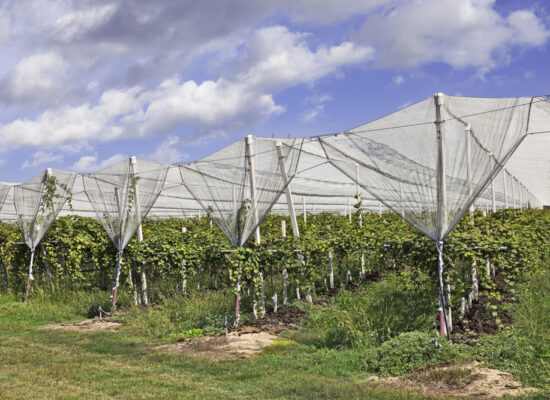
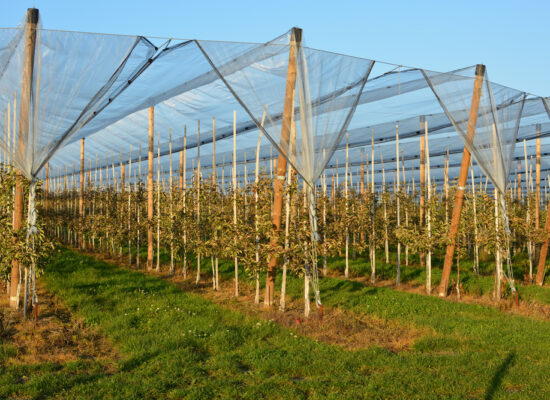
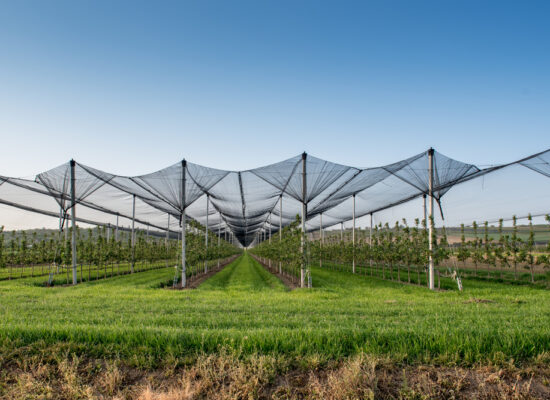
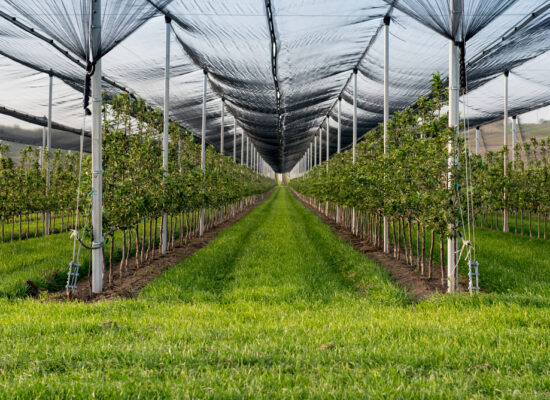
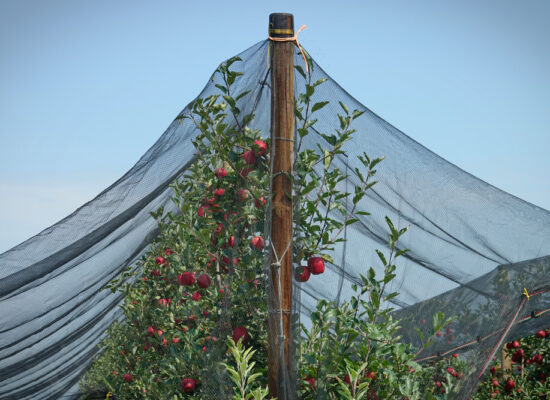
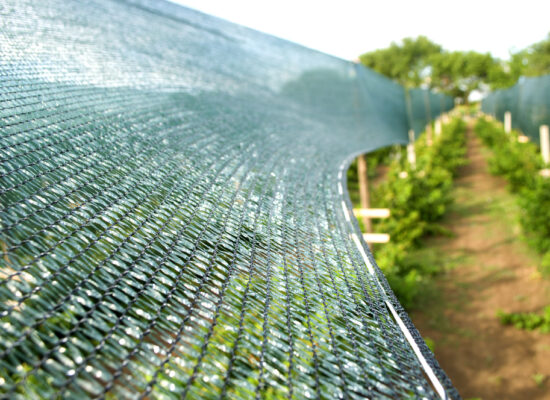
© Arbemu. All rights reserved